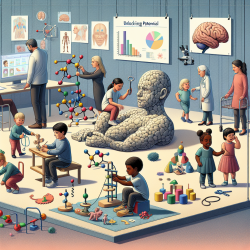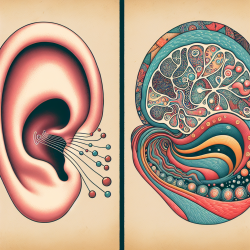Introduction
As speech-language pathologists, we are driven by a commitment to enhance the communication skills of children, ensuring they achieve their fullest potential. In our quest for effective interventions, staying informed about the latest research is crucial. The study titled "Bi-allelic JAM2 Variants Lead to Early-Onset Recessive Primary Familial Brain Calcification" offers insights that can significantly impact our therapeutic approaches.
Understanding JAM2 Variants
Primary familial brain calcification (PFBC) is a neurodegenerative disorder marked by calcium deposits in the brain, leading to a spectrum of neurological and psychiatric symptoms. The recent identification of bi-allelic variants in the JAM2 gene provides a new understanding of this condition. JAM2 encodes a protein crucial for maintaining the blood-brain barrier's integrity, and its dysfunction is linked to brain calcification.
Implications for Practice
For practitioners, this research highlights the importance of considering genetic factors when assessing and planning interventions for children with neurodevelopmental disorders. Here are some actionable insights:
- Comprehensive Assessment: Incorporate genetic testing into the assessment process for children presenting with unexplained neurological symptoms. Understanding the genetic underpinnings can lead to more targeted interventions.
- Interdisciplinary Collaboration: Work closely with geneticists and neurologists to develop a holistic understanding of each child's condition. This collaboration can enhance the precision of therapeutic strategies.
- Personalized Interventions: Tailor therapy plans to address specific neurological impairments associated with JAM2 variants. For example, focus on motor speech disorders if cerebellar ataxia is present.
Encouraging Further Research
While the study provides valuable insights, it also opens avenues for further research. Practitioners are encouraged to engage in or support studies that explore:
- Longitudinal Outcomes: Investigate the long-term effects of JAM2-related interventions on speech and language development.
- Therapeutic Efficacy: Assess the effectiveness of various therapeutic approaches in managing symptoms associated with JAM2 variants.
- Innovative Therapies: Explore novel therapeutic techniques, such as neurofeedback or virtual reality, to support children with brain calcification disorders.
Conclusion
Understanding the role of JAM2 variants in brain calcification provides a new lens through which we can view and address complex neurodevelopmental disorders. By integrating these insights into our practice, we can better support children in overcoming communication challenges and achieving their potential.
To read the original research paper, please follow this link: Bi-allelic JAM2 Variants Lead to Early-Onset Recessive Primary Familial Brain Calcification.










